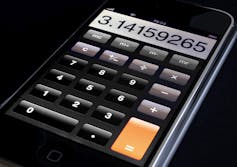Since the 1980s we have had access to calculators of various types. Today, we can include computers and smartphones – which are attached to our hip 24/7. So does this ubiquitous access to calculators affect our ability to do maths in our heads like we used to?
Thirty years ago calculators promised immense opportunity – opportunity, alas, that brought considerable controversy. The sceptics predicted students would not be able to compute even simple calculations mentally or on paper. Multiplication, basic facts, knowledge would disappear. Calculators would become a crutch.
The controversy has not dissipated over time. As recently as 2012, the UK government announced it intended to ban calculators from primary classrooms on the grounds that students use them too much and too soon.
Research conducted in response to this found little difference in performance tests whether students used calculators or not. An earlier US study had found the same: the calculator had no positive or negative effects on the attainment of basic maths skills.
Researchers recommended moving the conversation on. What types of tasks and activities suit calculators? How can calculators complement and reinforce mental and written methods of arithmetic in maths?

Using calculators to extend maths
Teachers had high hopes that calculators would be used in enhancing and extending the learning of mathematics. While standard procedures for the four operations (+, -, x, ÷) would still be taught and the basic facts of arithmetic would still need to be mastered, calculators could facilitate the study of number patterns and the absence of tedious calculations would free students up to pose, model and solve interesting and relevant problems.
Rather than replacing mental computation, calculators actually make calculating more efficient. Even the simple four-function calculator is a powerful instrument for investigating a range of concepts that previously were not so easily accessed by young children independently.
Counting, skip counting, negative numbers, relationships between common and decimal fractions and other number patterns all open up. The calculator lets students investigate and generalise patterns in numbers that they have previously not had access to.
The “constant” function means young children can explore numbers to infinity, if they fancy, without being restricted to charts or number lines. Skip-counting is also possible using the constant function.
Multiplication tables are no longer limited to 12 x 12. In the diagram below the child is exploring the pattern made by entering 11+11 and continuing to press the Equals sign to see what happens to the pattern once you count beyond 99 by elevens.

Calculators have great potential in concept development. For example, what happens when you multiply or divide a number by 10 or 100? These generalisations are spectacularly demonstrated and discovered with a calculator, which frees students to ask more questions about number patterns.
In a 1997 review of the extent to which calculators were being used in schools, numerous studies were examined that indicated the use of calculators at primary levels had no detrimental effects on students’ arithmetic abilities.
Unfortunately, the research indicated that calculators were still being used for trivial things like checking answers and were making little difference in mathematics education.
Although teachers indicated their support for the use of calculators across all levels of primary school, there was little evidence that these ideas were being taken up and implemented. Parental disapproval of the use of calculators was cited as a possible cause of the limited take-up.
Calculators’ potential is not being achieved
In a 2008 study this finding was reiterated. Researchers reported that despite educators’ high hopes for digital technologies to transform maths education, the uptake, both internationally and in Australia, had been disappointing.
Influential in this has been the lack of professional development to assist teachers in planning and implementing teaching approaches that take advantage of the technology. British technologist Conrad Wolfram said in his TED talk:
From rockets to stock markets, many of humanity’s most thrilling creations are powered by math. So why do kids lose interest in it?

Wolfram pointed out that students in mathematics classes across the globe spend up to 80% of their time learning and practising mathematical procedures. This time could be spent more productively if the digital technology already in the classrooms was used more effectively and efficiently.
While mathematics is popular, challenging and useful in the real world, kids are rapidly losing interest in the subject in schools. Wolfram blames teaching that focuses on calculation by hand: it’s tedious and mostly irrelevant to real mathematics and the real world.
Sadly, the potential for calculators to transform school mathematics and enhance our facility with mental arithmetic is not being achieved. We are not being provided with opportunities to solve real and interesting mathematical problems in the most effective ways.
So to answer whether calculators are affecting our mental arithmetic: not as much as we would like them to.

